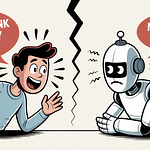The Shortcut That Comes at a Cost
We live in an era of infinite shortcuts. ChatGPT drafts our essays, summarizes articles, and gives feedback with a keystroke. But in this age of intelligent convenience, a quieter question has emerged: What is AI doing to the human mind it’s assisting?
A working paper from MIT’s Media Lab titled “Your Brain on ChatGPT: The Accumulation of Cognitive Debt” answers that question with real data—and real brainwaves. Through EEG scans, essay analysis, and memory testing, the study shows that when people write with ChatGPT, their brains work less. Neural connectivity drops, memory declines, and users struggle to recall or reflect on their own work.
“The LLM condition showed the weakest brain connectivity and learning outcomes.” (MIT Media Lab, 2025)
And the metaphor researchers propose is as memorable as it is cautionary: cognitive debt. The idea that we’re borrowing mental effort from the future—at a cost.
🧬 Inside the Experiment
MIT recruited 54 participants and split them into three writing conditions:
LLM Group: Wrote essays using ChatGPT
Search Group: Used Google for research, no AI assistance
Brain-Only Group: Wrote unaided, relying solely on their own thinking
Each participant wore EEG sensors to monitor brain activity, while their essays were analyzed for linguistic complexity, originality, and coherence. After writing, they were asked to recall and explain their own arguments.

“We observed a measurable reduction in alpha and beta wave activity—signals associated with attention and active cognitive processing—in the LLM group.” (MIT Media Lab, 2025)
📉 What the Brain Does—And Doesn’t Do—With AI
Participants in the brain-only group had the strongest engagement in brain regions tied to synthesis, critical evaluation, and memory encoding.
“Those who used their own brains to write—unaided—showed stronger connectivity in parietal and prefrontal regions associated with synthesis, evaluation, and memory encoding.” (MIT Media Lab, 2025)
LLM users, meanwhile, produced essays that looked fluent—but were cognitively hollow.
“Despite producing grammatically coherent essays, LLM users were less likely to understand or remember their content minutes later.” (MIT Media Lab, 2025)
In fact, many could not recall their own thesis or cited sources moments after submission.
“LLM usage impaired not just memory retention, but also the ability to reflect on and recall one's own writing.” (MIT Media Lab, 2025)
💬 Ownership and Originality
Even more concerning was the drop in ownership and originality. Essays written with AI were linguistically flatter and structurally repetitive.
“Participants using LLMs produced essays with lower linguistic complexity and originality.” (MIT Media Lab, 2025)
Students also expressed emotional detachment from the final product.
“Students reported feeling a lack of ownership over work completed with AI assistance.” (MIT Media Lab, 2025)
This aligns with broader findings: writing isn’t just output—it’s thinking. And offloading that process weakens internal reflection.

🔄 The Switch Test: Can We Bounce Back?
In a fourth session, some participants switched groups. Brain-only writers got access to ChatGPT; LLM users had their tool removed.
“In the final session, participants who had been using LLMs struggled to re-engage their cognitive faculties after the tool was removed.” (MIT Media Lab, 2025)
Conversely, those who started with their own thinking continued to engage critically even when given AI tools. They seemed to use LLMs strategically, not passively.
“This suggests that reliance on LLMs may hinder the neural development of critical thinking and reflective writing.” (MIT Media Lab, 2025)
🧾 Cognitive Debt: A Framework for the AI Age
The study doesn’t call for banning ChatGPT. Instead, it proposes a powerful framework: cognitive debt. Like a credit card for the brain, the metaphor captures the seductive convenience and subtle cost of outsourcing thinking.
“We propose the term cognitive debt to describe the cumulative disengagement and reduced learning observed in LLM-dependent workflows.” (MIT Media Lab, 2025)
Used wisely, AI can amplify learning. Used blindly, it can dull the very faculties we hope to develop.
🔮 Toward an AI-Augmented Mind
The future lies in cognitive design—teaching people how to use AI in ways that build rather than bypass thinking. That means:
Drafting by hand before refining with AI
Using ChatGPT as a coach or partner, not a ghostwriter
Building AI literacy into every level of education
Because at the end of the day, the goal isn’t to write better essays—it’s to become better thinkers.
Think First. Then Prompt.
The MIT study asks us to consider a deeper question: what’s at stake when we let machines do the hardest part of learning—the thinking itself?
AI is here to stay. But if we want to raise minds that can reason, reflect, and remember, we’ll need to be as intentional with our mental tools as we are with our physical ones.
Because every shortcut we take shapes the roads we’ll forget how to build.
Read the full paper here.
🎧 Acknowledgment Note for NotebookLM Podcast
Podcast production note:
The accompanying podcast episode for this article was drafted/recorded using Google’s NotebookLM, which helped summarize and synthesize key ideas from the original MIT Media Lab paper and supporting commentary. Special thanks to the NotebookLM team for their exploratory work in AI-assisted knowledge synthesis. Admittedly, all the research I do with NotebookLM keeps my brain from slowly deteriorating due to AI usage.
#mitmedialab #neuroscience #cognitivedebt #chatgpt #llms #aieducation #brainhealth #nataliyakosmyna #eugenehauptmann #yetongyuan #jessicasitu #xianhaoliao #ashlyberesnitsky #irisbraunstein #pattiemaes














Share this post